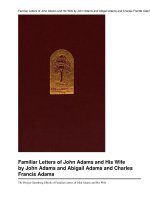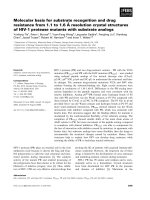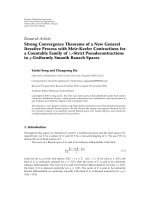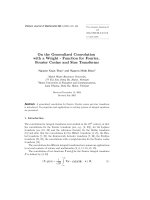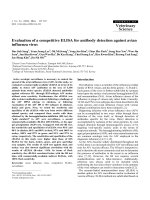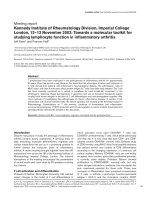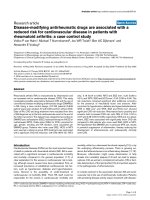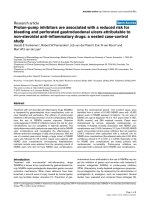comparison of the new mycofast revolution assay with a molecular assay for the detection of genital mycoplasmas from clinical specimens
Bạn đang xem bản rút gọn của tài liệu. Xem và tải ngay bản đầy đủ của tài liệu tại đây (183.21 KB, 6 trang )
Redelinghuys et al. BMC Infectious Diseases 2013, 13:453
/>
RESEARCH ARTICLE
Open Access
Comparison of the new Mycofast Revolution
assay with a molecular assay for the detection of
genital mycoplasmas from clinical specimens
Mathys J Redelinghuys1*†, Marthie M Ehlers1,2†, Andries W Dreyer1,2†, Hennie A Lombaard3 and Marleen M Kock1,2†
Abstract
Background: Genital mycoplasmas are opportunistic bacteria that are associated with undesirable gynaecologic
and reproductive events. Mycoplasmas are fastidious bacteria with increasing resistance to routine antimicrobials
and often fail to grow on conventional culture methods. The commercial Mycofast Revolution assay permits the
phenotypic detection and identification of genital mycoplasmas. Antimicrobial susceptibility testing against five
antimicrobial agents with MICs corresponding to the CLSI guidelines can also be performed. This study aimed to
compare the new commercially available Mycofast Revolution assay with a multiplex PCR assay.
Methods: Self-collected swabs were obtained from pregnant women attending the antenatal clinic of a tertiary
academic hospital in Pretoria, South Africa from October 2012 to November 2012. These swabs were used to seed
UMMt and modified Amies transport media. The seeded UMMt transported medium was used to inoculate the
Mycofast Revolution assay for the identification, enumeration and antimicrobial susceptibility testing of genital
mycoplasmas. Following DNA extraction from the modified Amies transport medium, specimens were subjected to
a multiplex PCR assay for the detection of genital mycoplasmas.
Results: The Mycofast Revolution kit had a sensitivity and specificity of 77.3% (95% CI: 62.15% to 88.51%) and 80%
(95% CI: 28.81% to 96.70%), respectively, against the PCR assay. The positive and negative predictive values were
97.1% (95% CI: 85.03% to 99.52%) and 28.6% (95% CI: 8.57% to 58.08%). Genital mycoplasmas were detected in
71.4% (35/49) of samples with the Mycofast Revolution assay with 49% (24/49) being Ureaplasma spp. and 22.4%
(11/49) mixed strains. The multiplex PCR assay had a positivity rate of 89.8% (44/49) for genital mycoplasmas; mixed
strains were present in 51% (25/49) of samples, Ureaplasma spp. in 16.3% (8/49) and M. hominis in 22.4% (11/49) of
samples.
Conclusions: There was a fair agreement (κ = 0.319) between the Mycofast Revolution assay and the mPCR assay.
With the high prevalence rates of genital mycoplasmas, fast and efficient diagnostic methods are imperative to
treat infections and minimise complications. The Mycofast Revolution assay is simple to use, has a short turnaround time and interpretation of results are straightforward. This assay circumvents common problems
experienced with conventional culture and molecular methods in diagnostic laboratories where skilled personnel
are limited and can be used as an alternative diagnostic assay.
Keywords: Mycoplasma hominis, Ureaplasma spp, Mycofast, Antimicrobial susceptibilities, Multiplex PCR assay
* Correspondence:
†
Equal contributors
1
Department of Medical Microbiology, University of Pretoria, Pretoria, South
Africa
Full list of author information is available at the end of the article
© 2013 Redelinghuys et al.; licensee BioMed Central Ltd. This is an Open Access article distributed under the terms of the
Creative Commons Attribution License ( which permits unrestricted use,
distribution, and reproduction in any medium, provided the original work is properly cited.
Redelinghuys et al. BMC Infectious Diseases 2013, 13:453
/>
Background
Genital mycoplasmas, including Mycoplasma genitalium,
M. hominis and Ureaplasma spp. are potentially pathogenic bacteria that frequently colonise the genitourinary
system of sexually active individuals [1]. Infections by
these bacteria can lead to genital infections as well as
undesirable sequelae during pregnancy [2,3]. The challenge of conventional methods to diagnose mycoplasmas
forces researchers to investigate more sensitive, reliable
and rapid alternatives. Susceptibility testing becomes
prominent in the background of widespread antimicrobial resistance and topographical variation and must be
incorporated in these testing systems.
Bacterial resistance to routine antimicrobial agents is a
growing and worldwide problem. The lack of a rigid cell
wall renders genital mycoplasmas innately resistant to
antimicrobial agents, such as β-lactam antibiotics and
vancomycin [4]. General treatment options include agents
like tetracyclines and fluoroquinolones [5]. Fluoroquinolone antimicrobial agents can be used to treat genital
mycoplasma infections caused by strains that are resistant
to agents, such as the tetracycline agent doxycycline [6].
Agents that are frequently used include ofloxacin, ciprofloxacin, levofloxacin, gemifloxacin and moxifloxacin [7].
Moxifloxacin is a more recent quinolone, which has the
highest in vitro activity against genital mycoplasmas [7].
These agents interact with the DNA gyrase and topoisomerase IV of bacteria [8]. Accordingly, fluoroquinolone resistance is associated with mutations in the gyrA and gyrB
genes and the parC and parE genes [9]. Tetracyclines and
fluoroquinolones are the drugs of choice, yet these agents
are contraindicated in pregnancy [10,11]. During pregnancy, macrolides like erythromycin are often used [1,11].
Strains of M. hominis have natural resistance to C14
and C15 macrolides (e.g. clarithromycin, erythromycin,
azithromycin and roxithromycin), while Ureaplasma spp.
are resistant to lincosamides like clindamycin [12,13].
Resistance of Ureaplasma spp. to macrolides is widely
reported and is associated with mutations in the 23S
rRNA gene [14,15]. Tetracycline resistance is found
in no less than 10% of Ureaplasma strains and approximately 40% of these resistant strains demonstrate cross-resistance to erythromycin [16]. Increased
resistance to tetracyclines in Ureaplasma spp. and M.
hominis is associated with the presence of the moveable tet(M) genetic element, the solitary tetracycline
resistance mechanism, which renders ribosomes resistant to this agent [17,18].
Phenotypic and genotypic methods for the identification of mycoplasmas are available. Culture is still
regarded as the gold standard for the detection of recoverable bacteria like M. hominis and Ureaplasma spp.;
however, a low sensitivity when compared to polymerase chain reaction (PCR) assays has been reported
Page 2 of 6
[19,20]. Culture is labour intensive and time consuming
as it requires the use of an enrichment broth for up to
seven days, followed by sub-culturing on solid media.
Analytical sensitivities in the range of 60% are only
obtained in skilled laboratories and identification is restricted to the genus level. The development of commercially available diagnostic assays, which are based on
liquid broth cultures provide easy to use and faster alternatives to conventional culture methods for the detection of genital mycoplasmas [21]. The difficulty of
laboratory culture methods to isolate M. genitalium
complicates antimicrobial susceptibility testing [22].
There is currently no approved commercially available
diagnostic assay for the detection and antimicrobial resistance testing of M. genitalium; detection is mainly
done by nucleic acid amplification tests (NAATs) [23].
The new commercially available Mycofast Revolution
(ELiTech Diagnostic, France) assay is a CE approved assay
(European Conformity; A mandatory European marking
for certain product groups to indicate conformity with the
essential health and safety requirements set out in
European Directives). This assay provides easy identification and enumeration of M. hominis and/or Ureaplasma
spp. within 24 h to 48 h [24]. The Mycofast Revolution
assay is a liquid method based on the ability of Ureaplasma spp. and Mycoplasma hominis to metabolize urea
and arginine, respectively and consists of 20 wells that are
pre-coated with a dehydrated culture medium (foal serum,
yeast extract, cysteine, arginine, urea, phenol red and
antibiotics) and contains a single broth with antimicrobials
for transport and preservation of genital mycoplasmas
(UMMt) (ELiTech Diagnostic, France). The Mycofast
Revolution assay includes an additional screening tray,
which can be used prior to inoculation to differentiate between positive and negative specimens and is much more
cost-effective. The screening tray and test trays allow the
detection of genital mycoplasmas at concentrations ≤103
colour change units per millilitre (ccu/ml) and >103 ccu/
ml, respectively.
Other commercially available diagnostic assays that
are similar with regards to genital mycoplasma identification, antimicrobial susceptibility testing, turnaround time and ease of use include the Mycoplasma
Duo kit (Sanofi Diagnostics Pasteur, France), the
Mycoview (Ivagen) and MycoIST2 (BioMérieux) test
kits [14,25]. The advantage of the Mycofast Revolution assay is that antimicrobial susceptibility testing is
performed against different antimicrobial agents with
specific minimum inhibitory concentrations (MICs) as
defined by the 2011 Clinical and Laboratory Standards Institute (CLSI) guidelines. Antimicrobial susceptibility testing is performed against five antimicrobial
agents that include levofloxacin, moxifloxacin, erythromycin, clindamycin and tetracycline [24].
Redelinghuys et al. BMC Infectious Diseases 2013, 13:453
/>
Molecular methods, such as PCR assays are reported to
be more sensitive for diagnostic purposes than culture [26].
Waites et al. [26] indicated that PCR-positive, culturenegative specimens are likely to represent true positives
due to the much higher sensitivity. Genotypic methods
also allow for speciation, which is a limitation of culture
[26]. Other advantages include rapid detection as well
as that these assays do not rely on the viability of the
bacterium for detection [27]. Furthermore, when using
a multiplex PCR (mPCR) assay, the detection of more
than one target in a single reaction is possible and this
can simplify the workflow [28].
The new commercially available Mycofast Revolution
assay may have the potential to be used as a simplified
and cost effective method to diagnose genital mycoplasmas. The purpose of the study was to compare the
Mycofast Revolution assay with an mPCR assay for the
detection of genital mycoplasmas from clinically collected vaginal specimens.
Methods
The study was conducted at the Department of Medical
Microbiology, University of Pretoria from October 2012
to November 2012. Ethical approval was obtained from
the Student Research Ethics Committee of the University of Pretoria prior to commencement of the study
(Approved protocol number: S6/2012). The study population included pregnant women attending the antenatal
clinic at a tertiary academic hospital in Pretoria, Gauteng,
South Africa. The inclusion criteria of participants in this
study were pregnant women attending the antenatal clinic
who were older than 18 years and who gave written
informed consent. All non-pregnant women, pregnant
women younger than 18 years or pregnant women who
did not give written informed consent were excluded from
this study.
Two self-collected vaginal swabs (Copan Diagnostics,
Inc, Italy) were obtained from fifty pregnant women. The
order in which the swabs were obtained was randomised
between patients. After collection, a dry Rayon swab was
used to seed 3 ml transport (UMMt) medium of the
Mycofast Revolution assay; the second swab (a flocked
nylon swab) was inoculated into 1 ml of modified Amies
transport medium (Copan Diagnostics, Inc, Italy) and
used for PCR analysis. Inoculated media and reagents
used were stored at 2°C to 8°C, whereas consumables were
stored at room temperature (±25°C). The inoculated
modified Amies transport medium was stored at −20°C
until DNA extraction was performed (within ±2 weeks of
specimen collection). Extracted DNA was stored at −20°C
until PCR analysis (done within ±1 week after DNA
extraction).
The swabs and the transport media were processed
according to the manufacturer’s instructions. Briefly,
Page 3 of 6
100 μl of seeded UMMt medium was added to the M.
hominis (MH) and U. urealyticum (UU) wells of the
Mycofast Screening Revolution tray with an additional
50 μl of MH supplement (S.Mh) added to the MH well.
The wells were covered with two drops of sterile mineral
oil and the tray was incubated (Vacutec, South Africa) at
37°C ± 1°C for 24 h. After incubation, the wells were observed for any colour changes. Orange or red colour
changes indicated the presence of M. hominis and/or
Ureaplasma spp., whereas yellow wells marked the absence of mycoplasmas. In the case of a positive screening
test, the excess UMMt medium that was stored at 2°C to
8°C was used to inoculate the Complement Mycofast
Revolution tray. Wells 1 to 20 were filled with 100 μl of
seeded UMMt medium, wells 6 to 7 filled with an additional 50 μl of S.Mh and all the wells were covered with
two drops of mineral oil. The tray was incubated (Vacutec,
South Africa) at 37°C ± 1°C for 24 h (maximum 48 h in
all cases) and after incubation observed for colour changes
similar to that of the screening tray. Mycoplasma hominis
(MH) identification wells contained erythromycin to inhibit the growth of Ureaplasma spp., while the UU wells
contained lincomycin to inhibit the growth of M. hominis.
The specific breakpoints (in μg/mL) indicating susceptibility (S) or resistance (R) for Ureaplasma spp. are as
follow [24]: levofloxacin S ≤ 2, R ≥ 4; moxifloxacin S ≤ 2;
erythromycin S ≤ 8, R ≥ 16; tetracycline S ≤ 1, R ≥ 2. The
breakpoints for M. hominis are as follow: levofloxacin
S ≤ 1, R ≥ 2; moxifloxacin S ≤ 0.25; clindamycin S ≤ 0.25,
R ≥ 0.5; tetracycline S ≤ 4, R ≥ 8. Strains were regarded as
resistant when growth was inhibited by the higher critical concentration of the antimicrobial agent, but not the
lower critical concentration or when growth was not
inhibited by either the higher or lower critical concentrations of the antimicrobial agents.
Specimens were subjected to a human β-globin PCR
assay to serve as an internal control and monitor possible PCR inhibitors. The mPCR assay used was done
according to Stellrecht et al. [29] but in multiplex
format with the following modifications: 40 PCR cycles
and primers at final concentrations of 0.2 μM with the
Qiagen multiplex PCR kit (Qiagen, Germany). This
method was previously compared to the gold standard
(culture on A7 agar) for genital mycoplasma identification and showed good sensitivity, specificity and positive
and negative predictive values (87%, 96%, 94% and 93%,
respectively) for the detection of genital mycoplasmas
[29]. The mPCR assay was conducted with primers
targeting genes specific for M. genitalium, M. hominis,
U. parvum and U. urealyticum [29]. Oligonucleotide
primers were synthesised by Inqaba Biotechnical Industries, South Africa. The mPCR assay was validated with
AmpliRun Mycoplasma genitalium DNA control (Vircell
SL, Spain), a positive M. hominis specimen isolated with
Redelinghuys et al. BMC Infectious Diseases 2013, 13:453
/>
Page 4 of 6
Table 1 Results of M. hominis and Ureaplasma spp. after the Mycofast Revolution and mPCR assay analyses (n = 49)
Assay
M. hominis (MH)1
No (%)
Ureaplasma spp. (UU + UP)1
No (%)
Mixed isolation: MH + (UU + UP)
No (%)
Negatives No (%)
Total
Mycofast Revolution
0
24 (49)
11 (22.4)
14 (28.6)
49
PCR
11 (22.4)
8 (16.3)
25 (51)
5 (10.2)
49
1
Where MH is M. hominis, UP is U. parvum and UU is U. urealyticum.
A2 agar and reference strains ATCC 27813 (U. parvum)
and ATCC 27619 (U. urealyticum).
Statistical analysis was performed using the PCR assay
as the gold standard to calculate the sensitivity, specificity,
positive predictive value and negative predictive value of
the Mycofast Revolution assay. The positivity rates of both
assays were determined and the agreement between the
two methods was determined by the kappa (κ) statistic.
The κ value, a measure of test reliability, was interpreted
as follows: < 0.2, poor; 0.21 to 0.4, fair; 0.41 to 0.6, moderate; 0.61 to 0.8, good; ≥ 0.81, excellent [30].
for erythromycin and tetracycline to which 100% (11/11)
of the isolates were resistant.
The mPCR assay detected genital mycoplasmas in 89.8%
(44/49) of specimens. Ureaplasma spp. were detected in
16.3% (8/49), while M. hominis was detected in 22.4% (11/
49) of specimens. Fifty-one percent (25/49) of specimens
were positive for both Ureaplasma spp. and M. hominis.
The mPCR assay results showed only 10.2% (5/49) of
specimens to be negative.
Statistical analysis, when considering the mPCR assay
as the gold standard, showed a sensitivity and specificity
of 77.3% (95% CI: 62.15% to 88.51%) and 80% (95% CI:
28.81% to 96.70%), respectively for the Mycofast Revolution assay to detect genital mycoplasmas. The positive
and negative predictive values were 97.1% (95% CI:
85.03% to 99.52%) and 28.6% (95% CI: 8.57% to 58.08%),
respectively. The kappa statistic was 0.319.
Results
A total of 49 samples were included in this study. Contamination was observed in one specimen (2%) that was
excluded from the analysis. The number of specimens
that tested positive and negative with the Mycofast
Revolution (phenotypic) and the mPCR (genotypic) assays as well as the breakdown according to species are
displayed in Table 1.
Genital mycoplasmas were detected in 71.4% (35/49)
of samples with the Mycofast Revolution assay. Fortynine percent (24/49) of cultures were positive for Ureaplasma spp., while none of the cultures were positive for
only M. hominis. Mixed strains (M. hominis and Ureaplasma spp.) were present in 22.4% (11/49) of cultures.
Mixed strains were determined when the identification
wells of both M. hominis and Ureaplasma spp. gave
positive results. Mycoplasmas were not detected in
28.6% (14/49) of specimens. One sample was positive
with the Mycofast Revolution assay but negative with
the mPCR assay.
Ureaplasma spp. were resistant to levofloxacin and
moxifloxacin in 42% (10/24) and 4% (1/24) of cases, respectively (Table 2). Ureaplasma spp. had susceptibilities
of 25% (6/24) and 21% (5/24) to erythromycin and tetracycline, respectively. The resistance patterns for mixed
isolates were similar to those of Ureaplasma spp., except
Discussion
This study is the first to compare the Mycofast Revolution commercial assay against an mPCR assay for the
detection of genital mycoplasmas from clinical specimens in South Africa. There was a fair agreement
(κ = 0.319) between the results of the phenotypic and
genotypic methods. The Mycofast Revolution assay
showed a high sensitivity and specificity, of 77% and 80%
respectively, considering it only detects viable bacteria.
However, this contributed to a low negative predictive
value (28.6%) when the mPCR assay was considered the
gold standard.
The positivity rates reported in this study are high
(71% for the Mycofast Revolution and 91.8% for the
mPCR assays). A study by Bayraktar et al. [31] in pregnant
women, including symptomatic and asymptomatic control
patients, reported a prevalence of 29% for genital mycoplasmas. A Greek study (2009) reported a prevalence of
37% in outpatient women with clinical vaginitis [32]. Both
of these studies identified genital mycoplasmas with the
Table 2 The distribution (%) of Ureaplasma spp. and M. hominis at different breakpoints of antimicrobial agents
(n = 49)
Levofloxacin
1
1
Ureaplasma species (n = 24)
50
Ureaplasma species and M. hominis (n = 11)
73
The breakpoints in μg/mL according to the CLSI guidelines .
1
24
Moxifloxacin
Erythromycin
Clindamycin
Tetracycline
2
4
0.25
2
8
16
0.25
0.5
1
2
4
8
29
13
88
4
71
4
0
100
17
25
4
33
18
9
82
9
9
91
0
100
9
18
9
64
Redelinghuys et al. BMC Infectious Diseases 2013, 13:453
/>
commercially available Mycoplasma IST-2 kit. Govender
et al. screened low-risk antenatal patients in South Africa
at their first antenatal visit (16 to 23 weeks’ gestation) for
mycoplasmas at two different time frames (2003 and
2005) [3]. This research group used an mPCR assay and
documented prevalence rates of genital mycoplasmas of
almost 80% and around 40% in 2003 and 2005, respectively [3]. Nonetheless, the type of assay may have an effect
on the accurate detection of genital mycoplasmas, depending on the growth factors and antimicrobial agents
included in the media of the commercial assay.
A higher detection rate was observed for Ureaplasma
spp. (detected alone in 24% of specimens) compared to
M. hominis (never detected alone) with the Mycofast
Revolution assay. The opposite was true for the mPCR
assay with M. hominis being detected more frequently
(detected alone in 22.4% of specimens, 6.1% more than
the single detection of Ureaplasma spp.). The reason for
the higher detection rate by the mPCR assay could be
ascribed to specimens containing a low concentration of
bacteria that were not detected after 48 h with the
Mycofast Revolution assay. In such cases, the presence
of genital mycoplasmas may possibly be colonisation instead of infection as the Mycofast Revolution assay is
designed to detect whether the pathological threshold
was reached.
A limitation of the Mycofast Revolution assay is that a
low concentration of M. hominis may result in random
wells to turn positive. Nonetheless, a specimen would
only be regarded as positive if the identification wells are
positive and the pathological thresholds are reached.
The Mycofast Revolution assay does not distinguish between the species, U. parvum and U. urealyticum and
analysis with additional molecular methods is needed for
speciation. The specimen which tested positive with the
Mycofast Revolution assay but negative with the PCR
assay was neither re-extracted nor repeated with a PCR
assay.
Although PCR assays have the advantage of being
sensitive, it remains costly and is dependent on skilled
personnel. The inoculation and handling of the Mycofast
Revolution assay do not require skilled personnel and
the results are easy to interpret. In addition, the Mycofast
Revolution assay allows quantitation of the number of
mycoplasmas present and gives an indication of colonisation or infection. Despite the lower observed sensitivity of
the Mycofast Revolution assay compared to the mPCR
assay, the main advantage of the Mycofast Revolution
assay is that it tests the activity of a variety of new antimicrobial agents against genital mycoplasmas with
updated MICs as defined by the 2011 CLSI guidelines
[24]. This may reduce the cost of antimicrobial surveillance and renders the Mycofast Revolution assay of clinical importance in the era of increasing antimicrobial
Page 5 of 6
resistance. The Mycofast Revolution assay may be an acceptable assay to use in routine diagnostic laboratories in
South Africa where resources are limited. It may be used
as an alternative in laboratories where insensitive conventional culture methods are used.
The difference in the findings between the two assays
can be ascribed to numerous factors, including different
bacterial loads on the different swabs, the viability of
bacteria and the difference in analytical sensitivities of
the two assays. A limitation of the study was that an
additional molecular assay was not used to resolve the
discrepancies between the two assays.
Conclusions
The Mycofast Revolution assay could be considered as a
cost-effective alternative to conventional culture methods
for the rapid detection of genital mycoplasmas. The assay
may allow laboratory personnel to provide the clinician
with a result in a short period (± 48 hours) of time together with antimicrobial susceptibility data. Antimicrobial susceptibility patterns are vital as successful treatment
will depend on the early administration of effective antimicrobial agents. In pregnant women it is particularly important to reduce these infections to prevent adverse
pregnancy outcomes.
Competing interests
None to declare. The authors would like to thank Separation Scientific for
supplying the Mycofast Revolution kits used in this study. The authors would
also like to thank the University of Pretoria, the Medical Research Council
(South Africa) and the National Health Laboratory Service (NHLS) for financial
assistance received.
Authors’ contributions
MJR was involved in concept design, laboratory work as well as writing of
the manuscript. MMK, MME and AWD were involved in concept design of
the study as well as critical review of the manuscript. HL was involved in
concept design of the study as well as overseeing the logistics of sample
collection. All authors read and approved the final manuscript.
Author details
1
Department of Medical Microbiology, University of Pretoria, Pretoria, South
Africa. 2Department of Medical Microbiology, Tshwane Academic Division,
National Health Laboratory Service, Pretoria, South Africa. 3Department of
Obstetrics and Gynaecology, University of Pretoria, Pretoria, South Africa.
Received: 14 March 2013 Accepted: 26 September 2013
Published: 30 September 2013
References
1. Koh E, Kim S, Kim I, Maeng K, Lee S: Antimicrobial susceptibilities of
Ureaplasma urealyticum and Mycoplasma hominis in pregnant women.
Korean J Clin Microbiol 2009, 12:159–162.
2. Xiao L, Glass JI, Paralanov V, Yooseph S, Cassell GH, Duffy LB, Waites KB:
Detection and characterization of human Ureaplasma species and
serovars by real-time PCR. J Clin Microbiol 2010, 48:2715–2723.
3. Govender S, Theron GB, Odendaal HJ, Chalkley LJ: Prevalence of genital
mycoplasmas, ureaplasmas and chlamydia in pregnancy. J Obstet
Gynaecol 2009, 29:698–701.
4. Waites KB, Katz B, Schelonka RL: Mycoplasmas and ureaplasmas as
neonatal pathogens. Clin Microbiol Rev 2005, 18:757–89.
5. Patel MA, Nyirjesy P: Role of Mycoplasma and Ureaplasma Species in Female
Lower Genital Tract Infections. Curr Infect Dis Rep 2010, 12:417–422.
Redelinghuys et al. BMC Infectious Diseases 2013, 13:453
/>
6.
7.
8.
9.
10.
11.
12.
13.
14.
15.
16.
17.
18.
19.
20.
21.
22.
23.
24.
25.
Duffy LB, Crabb D, Searcey K, Kempf C: Comparative potency of
gemifloxacin, new quinolones, macrolides, tetracycline and clindamycin
against Mycoplasma spp. J Antimicrob Chemother 2000, 45:29–33.
Bébéar CM, de Barbeyrac B, Pereye S, Renaudin H, Clerc M, Bébéar C:
Activity of moxifloxacin against the urogenital mycoplasmas Ureaplasma
spp., Mycoplasma hominis and Mycoplasma genitalium and Chlamydia
trachomatis. Clin Microbiol Infect 2008, 14:801–805.
Bébéar CM, Renaudin H, Charron A, Clerc M, Pereyre S, Bébéar C: DNA
gyrase and topoisomerase IV mutations in clinical isolates of Ureaplasma
spp. and Mycoplasma hominis resistant to fluoroquinolones.
Antimicrob Agents Chemother 2003, 47:3323–3325.
Beeton ML, Chalker VJ, Maxwell NC, Kotecha S, Spiller OB: Concurrent
titration and determination of antibiotic resistance in Ureaplasma
species with identification of novel point mutations in genes associated
with resistance. Antimicrob Agents Chemother 2009, 53:2020–2027.
Bébéar CM, Kempf I: Antimicrobial therapy and antimicrobial resistance.
In Mycoplasmas: Molecular biology, Pathogenicity and strategies for control.
Edited by Blanchard A, Browning GF. United Kingdom: Horizon Bioscience;
2005:535–568.
Raynes-Greenow CH, Roberts CL, Bell JC, Peat B, Gilbert GL, Parker S:
Antibiotics for ureaplasma in the vagina in pregnancy. Cochrane
Database Syst Rev 2011, (9):. Art.No.: CD003767. DOI: 10.1002/14651858.
CD003767.pub3.
Bébéar CM, Bébéar C: Antimycoplasmal agents. In Molecular biology and
pathogenicity of mycoplasmas. Edited by Razin S, Herrmann R. London:
Kluwer Academic/ Plenum Publishers; 2002:545–566.
Kechagia N, Bersimis S, Chatzipanagiotou S: Incidence and antimicrobial
susceptibilities of genital mycoplasmas in outpatient women with clinical
vaginitis in Athens, Greece. J Antimicrob Chemother 2008, 62:122–125.
Dongya M, Wencheng X, Xiaobo M, Lu W: Transition mutations in 23S
rRNA account for acquired resistance to macrolides in Ureaplasma
urealyticum. Microb Drug Resist 2008, 14:183–186.
Xiao L, Crabb DM, Duffy LB, Paralanov V, Glass JI, Hamilos CL, Waites KB:
Mutations in ribosomal proteins and ribosomal RNA confer macrolide
resistance in human Ureaplasma spp. Int J Antimicrob Agents 2011,
37:377–379.
Taylor-Robinson D: The role of mycoplasmas in pregnancy outcome. Best
Pract Res Clin Obstet Gynaecol 2007, 21:425–438.
Dégrange S, Renaudin H, Charron A, Bébéar C, Bébéar CM: Tetracycline
resistance in Ureaplasma spp and Mycoplasma hominis: Prevalence in
Bordeaux, France, from 1999 to 2002 and description of two tet(M)positive isolates of M. hominis susceptible to tetracyclines.
Antimicrob Agents Chemother 2008, 52:742–744.
Mardassi BBA, Aissani N, Moalla I, Dhahri D, Dridi A, Mlik B: Evidence for the
predominance of a single tet(M) gene sequence type in tetracyclineresistant Ureaplasma parvum and Mycoplasma hominis isolates from
Tunisian patients. J Med Microbiol 2012, 61:1254–1261.
Zeighami H, Peerayeh SN, Safarlu M: Detection of Ureaplasma urealyticum
in semen of infertile men by PCR. Pak J Biol Sci 2007, 10:3960–3963.
Cao X, Jiang Z, Wang Y, Gong R, Zhang C: Two multiplex real-time
TaqMan polymerase chain reaction systems for simultaneous detecting
and serotyping of Ureaplasma parvum. Diagn Microbiol Infect Dis 2007,
59:109–111.
Tarrant WP, Gonzalez-Berjon JM, Cernoch PL, Olsen RJ, Musser JM:
Spontaneous bacterial pericarditis with tamponade due to Ureaplasma
spp. J Clin Microbiol 2009, 47:1965–1968.
Edberg A, Jurstrand M, Johansson E, Wikander E, Höög A, Ahlqvist T, Falk L,
Jensen JS, Fredlud H: A comparative study of three different PCR assays
for detection of Mycoplasma genitalium in urogenital specimens from
men and women. J Med Microbiol 2008, 57:304–309.
Lillis RA, Nsuami MJ, Myers L, Martin DH: Utility of urine, vaginal, cervical
and rectal specimens for detection of Mycoplasma genitalium in women.
J Clin Microbiol 2011, 49:1990–1992.
CLSI: Methods for antimicrobial susceptibility testing for human mycoplasmas;
Approved guideline. CLSI Document M43-A. Wayne, PA: Clinical and
Laboratory Standards Institute; 2011.
Cheah F, Anderson TP, Darlow BA, Wang H: Comparison of the
Mycoplasma Duo test with PCR for detection of Ureaplasma species in
endotracheal aspirates from premature infants. J Clin Microbiol 2005,
43:509–510.
Page 6 of 6
26. Waites KB, Xiao L, Paralanov V, Viscardi RM, Glass JI: Molecular methods for
the detection of Mycoplasma and Ureaplasma infections in humans.
J Mol Diagn 2012, 14:437–450.
27. Gdoura R, Kchaou W, Ammar-Keskes L, Chakroun N, Sellemi A, Znazen A,
Rebai T, Hammami A: Assessment of Chlamydia trachomatis, Ureaplasma
urealyticum, Ureaplasma parvum, Mycoplasma hominis, and Mycoplasma
genitalium in semen and first void urine specimens of asymptomatic
male partners of infertile couples. J Androl 2008, 29:198–206.
28. McIver CJ, Rismanto N, Smith C, Naing ZW, Rayner B, Lusk MJ, Konecny P,
White PA, Rawlinson WD: Multiplex PCR testing detection of higherthan-expected rates of cervical Mycoplasma, Ureaplasma, and
Trichomonas and viral agent infections in sexually active Australian
women. J Clin Microbiol 2009, 47:1358–1363.
29. Stellrecht KA, Woron AM, Mishrik NG, Venezia RA: Comparison of multiplex
PCR assay with culture for detection of genital mycoplasmas. J Clin
Microbiol 2004, 42:1528–1533.
30. Landis JR, Koch GG: The measurement of observer agreement for
categorical data. Biometrics 1977, 33:159–174.
31. Bayraktar MR, Ozerol IH, Gucluer N, Celik O: Prevalence and antibiotic
susceptibility of Mycoplasma hominis and Ureaplasma urealyticum in
pregnant women. Int J Infect Dis 2010, 14:e90–95.
32. Amirmozafari N, Mirnejad R, Kazemi B, Sariri E, Bojari MR, Darkahi D:
Simultaneous detection of genital mycoplasma in women with genital
infections by PCR. J Biol Sci 2009, 9:804–809.
doi:10.1186/1471-2334-13-453
Cite this article as: Redelinghuys et al.: Comparison of the new Mycofast
Revolution assay with a molecular assay for the detection of genital
mycoplasmas from clinical specimens. BMC Infectious Diseases
2013 13:453.
Submit your next manuscript to BioMed Central
and take full advantage of:
• Convenient online submission
• Thorough peer review
• No space constraints or color figure charges
• Immediate publication on acceptance
• Inclusion in PubMed, CAS, Scopus and Google Scholar
• Research which is freely available for redistribution
Submit your manuscript at
www.biomedcentral.com/submit
